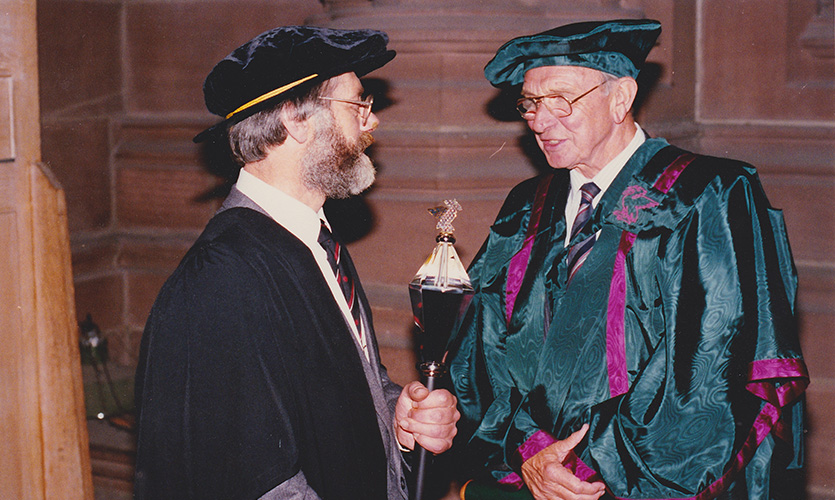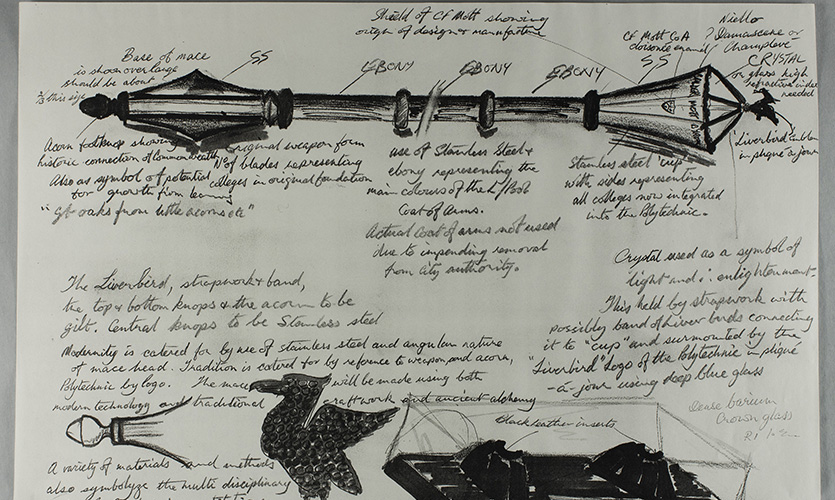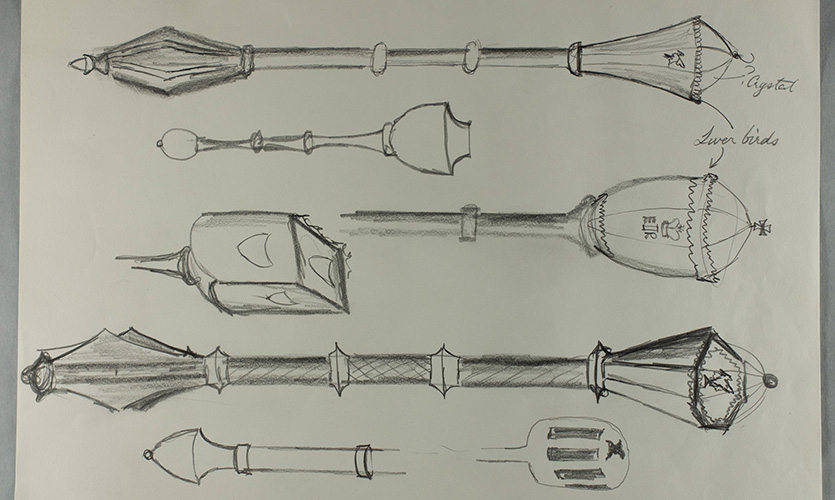Arthur Hyatt (1939-2022)
Arthur was born in Gloucestershire just before the start of the Second World War. Upon leaving secondary school he became an apprentice cabinet maker with renowned English designer Gordon Russell’s company. In 1960 he took a hiatus to complete his national service, later returning to the company before setting up his own joinery business in 1971.
In the early 1980s, Arthur decided that he wanted to train as a teacher and in 1984 moved to St Helens and began his education at the then Liverpool Polytechnic. He studied a B.Ed. course in Craft, Design and Technology, and in his fourth year of study he was asked to design a ceremonial mace for use at graduations, commissioned by the Rector, Professor Peter Toyne.
In the summer of 1988, after months of research, design, craft and sourcing of the relevant components, the ebony, steel and lead crystal mace made its debut and Arthur became the Polytechnic’s first ever mace bearer.
He went on to become a CDT teacher at a school in London, retiring in 1988 when he then moved to Bradford.
Upon his death in 2022, one of Arthur’s sons requested that the mace be displayed at his funeral. It meant a lot to the family to be reunited with the distinctive design as they said their final farewells.
“How can I ever begin to express adequately my thanks to you for your outstanding contribution to our degree ceremony. The mace is just wonderful and has been admired by all who have seen it; and your magisterial conveying of it in the procession was wonderful too...Again thanks for all you have done, not just this year but for the future ethos of our polytechnic. You will go down in the annals of its history!”
– Extract from a letter sent to Arthur in 1988 from Polytechnic Rector Professor Peter Toyne

In his design research folder, Arthur recalled the process that he went through when coming up with the design for the mace. He said:
“As a student of Liverpool Polytechnic, I undertook to design and make the mace as part of my B.Ed. studies in C.D.T. and feel fortunate to have had this opportunity. After all, not everyone gets to make a mace.
“My research brought me into contact with many interesting people and I was able to trace documentary links in the history of maces as far back as the Pharaohs of 3,500 or 2,500 B.C., according to which book one reads, though the Australian Aboriginal war mace may have even older origins. By sheer co-incidence, I have recently acquired a souvenir Maori Wahaika, which is their version of a war mace.
“The design of the polytechnic mace incorporates several symbolic features. Starting with the 'acorn' finial on what is now the base which is a nostalgic reference to the time when Cromwell ordered royal symbols to be removed from maces. It's inclusion on our mace seemed appropriate, since surely education should add to the 'commonwealth' of knowledge.
“The three flanges represent the three colleges merged with the main body of the polytechnic in 1984 to make Liverpool Polytechnic into the fourth largest in the UK. The ebony shaft and the stainless-steel knops and bell indicate the black and silver colours of the Liverpool City Arms.
“The bell, or cup, has ten sides, representing the ten schools into which the polytechnic has recently been re-organised. The lead crystal top casting the usual seven colour spectrum gives recognition to the previous arrangement of seven faculties while also symbolising polychromatically the variety of enlightenment which one hopes might be derived from the activities of the polytechnic.
“The Liverbird, without which anything associated with Liverpool would seem incomplete, is reflected within the crystal and in the top finial.
“Both are derived from the current polytechnic logo; the finial having been made 'plique a jour' to link it to the robes of office of the rector which were designed by the fashion department and have a similarly styled Liverbird on the sleeves. Thus, the mace is linked to the office whose authority it represents.
“I hope it will lend dignity to the occasions on which it is used and give pleasure to those future students receiving their degrees from the polytechnic.”
While a different mace is now used for the university’s graduation ceremonies at Liverpool’s Anglican Cathedral, Arthur’s original mace is looked after on campus as a distinct piece of LJMU history.



